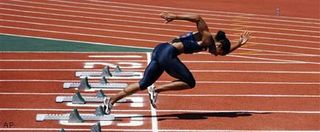Olympic Sprinters Nearest Starting Gun Get Advantage

The sprint events at the Beijing Olympics will be inherently unfair, a recent study suggests.
Scientists have discovered that reaction times for getting out of the blocks depends in part on how close a runner is to the starting gun. Yet lane assignments are chosen by a drawing.
Scientists studied reaction times of sprinters in two races at the 2004 Olympics and found that those closest to the starter had significantly faster reaction times out of the blocks. The average reaction time for sprinters in lane 1, nearest the gun, was 160 milliseconds. The average time for all other lanes combined as 175 milliseconds.
So the researchers did a test. They had four trained sprinters and 12 untrained participants perform sprint starts from starting blocks modified to measure horizontal force. Using a recorded gunshot as the ''go'' signal, they randomly presented the signal to test subjects at various decibel levels, from a low of 80 dB to a high of 120 dB.
The louder the gunshot, the faster the reaction time of the test subjects.
"In sprint events, where hundredths of a second can make the difference between a gold medal and a silver, minimizing reaction time can be the key to an athlete's success," said Alex Brown of the University of Alberta. "We suggest that procedures presently used to start the Olympic sprint events give runners closer to the starter the advantage of hearing the '"go" signal louder; consequently, they react sooner than their competitors."
Although this finding might make runners prefer to start off in lane 1, lanes currently are assigned by a drawing.
Sign up for the Live Science daily newsletter now
Get the world’s most fascinating discoveries delivered straight to your inbox.
The research, detailed in the June 2008 issue of the journal Medicine & Science in Sports & Exercise, could have implications beyond sports.
"Our findings might also be helpful for research in Parkinson's disease," said study leader Dave Collins, professor of physical education and recreation at the university. "People suffering from Parkinson's typically experience episodes of 'freezing,' where they want to move but cannot because of impaired processing in certain parts of the brain. By introducing a loud sound during a freezing episode we might be able to startle patients into moving as we know that faster reaction times induced by a startle response are due in part to bypassing the cortical circuits that are damaged in Parkinson's disease."
- Quiz: Test Your Olympic Knowledge
Most Popular



